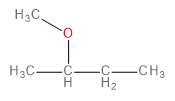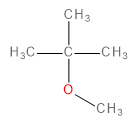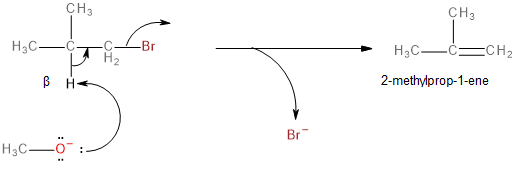Question
Question: The major product formed in the following reaction is 
A.

B.

C.

D.

Solution
Here we have an alkyl halide reacting with methoxide ion (CH3O− ) in the presence of methanol (CH3OH). The alkyl halide undergoes an elimination reaction called dehydrohalogenation.
Complete Step by Step Solution:
In this question, we have to predict the product that will be formed when 1-bromo-2-methylpropane reacts with a methoxide ion (CH3O− ) in the presence of methanol (CH3OH).
The methoxide ion is an electron-rich species having lone pairs on the oxygen atom. The carbon-bromine (C−Br ) bond in 1-bromo-2-methylpropane is polarised towards bromine because of its higher electronegativity. This makes the carbon atom a bit deficient in electrons. Therefore, one might think that the methoxide ion would substitute the bromine in a nucleophilic substitution reaction to form an ether as the final product.
However, this does not happen because the methoxide ion does not act as a nucleophile. Instead, it prefers to attack a hydrogen atom on 1-bromo-2-methylpropane and abstracts it as a proton (H+). Thus, the methoxide ion acts as a base.
When the methoxide ion acts as a base, it initiates an elimination reaction instead of a substitution reaction.
Although elimination reactions can occur via multiple mechanisms, in this case, the mechanism followed is a “bimolecular” elimination mechanism, also known as the E2 mechanism.
This is a single-step mechanism involving the abstraction of a beta-hydrogen as a proton and the elimination of bromine as a bromide ion (Br−) to form an alkene as the final, major product.

Image: Elimination reaction of 1-bromo-2-methylpropane to form 2-methylprop-1-ene
Thus, option C is correct.
Note: Nucleophilicity and basicity are not the same. Nucleophilicity refers to the ability of an electron-rich species to donate its lone pairs of electrons to electron-deficient species. Therefore, all nucleophiles are Lewis bases. But basicity refers to the ability of an electron-rich species to accept a proton. When an electron-rich species acts as an electron donor (i.e., a nucleophile), it causes substitution. When an electron-rich species acts as a proton acceptor (i.e., a base), it causes elimination. It is highly advised that students learn about the extent of nucleophilicities and basicities of different electron-rich species.
